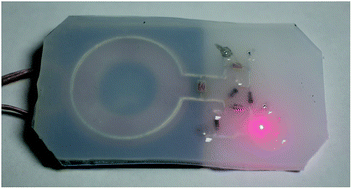A microfluidic wireless power system
Abstract
Electrical traces made using liquid metal can survive strains of tens or hundreds of percent without damage. Liquid metal is promising for creating the thick cross sections and low resistance necessary for power devices, while maintaining high stretchability. In this article, a stretchable wireless power receiver system is demonstrated featuring a liquid metal circuit board (galinstan traces embedded in silicone) to connect individual discrete components as well as to create the receiver inductor coil. The mechanical effects of embedding parts were also simulated using a numerical solver. The fluidic channels defining the liquid metal traces are built using a silicone molding and bonding process based on 3D printed molds. The system consists of an inductor-capacitor resonant tank, voltage-doubling diode rectifier for AC to DC conversion, and a representative load. Circuit operation was demonstrated up to 80% uniaxial mechanical strain.


 Please wait while we load your content...
Please wait while we load your content...